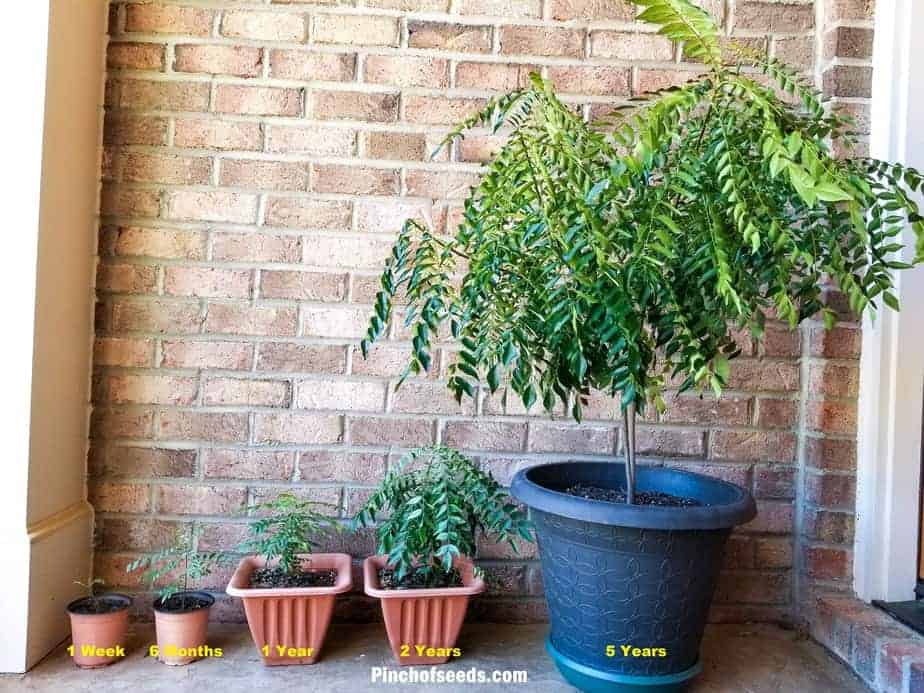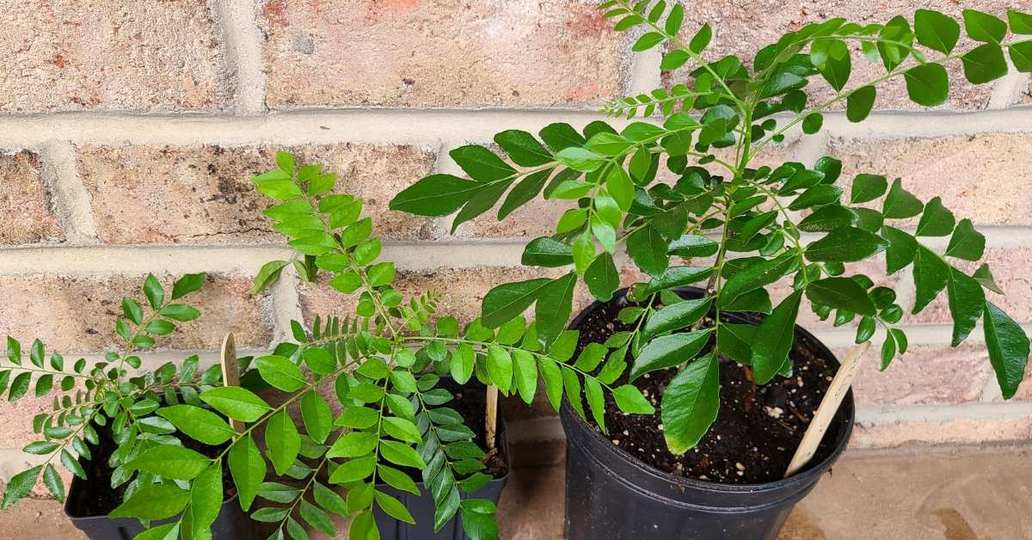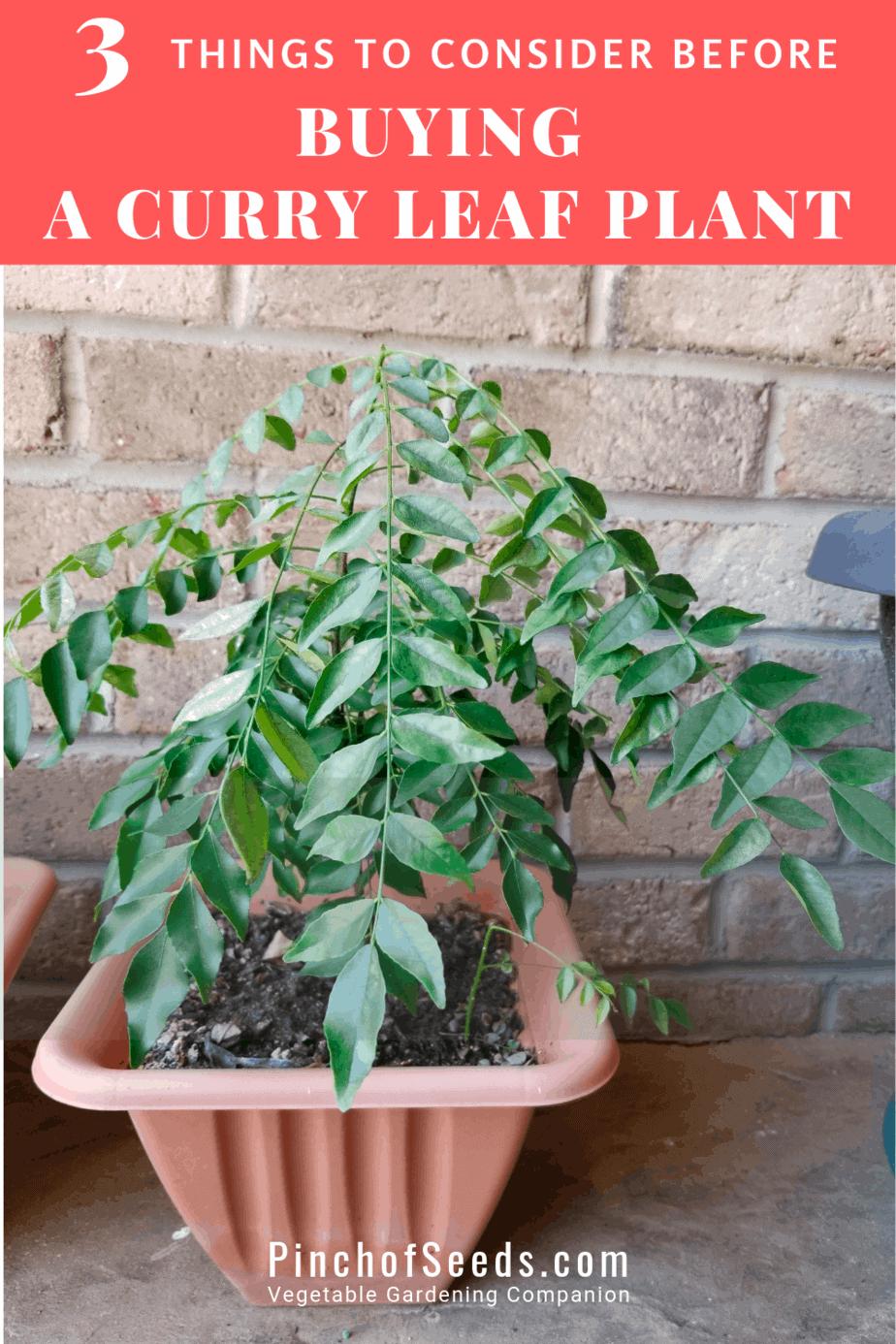The Curry Leaf plant is one of the most essential herbs for any Indian kitchen garden. It is also known as curry leaves plant, curry leaf tree, or curry patta plant. Every spring, my two fully grown curry leaf trees produce several short side- shoots near the base of the plants, a.k.a. Baby Curry leaves plants. Last year, I posted Indian Curry leaf plants for sale on my Facebook page, asking if anyone was interested in buying. An overwhelmingly large number of people responded with interest in buying a curry leaf plant.
When I started chatting with people interested in buying, I realized most had not raised a curry leaves plant before. They had big expectations from a baby plant.
They were under the impression that:
- Once you get a curry leaf plant, you will not have to buy curry leaves from the Indian grocery store.
- The curry leaf plant will provide large, glossy, green curry leaves for everyday cooking in a few short days.
- All you have to do is get a curry leaf plant, plant it in the garden or a pot and you are all set!
If you believe in any one of the above, you are seriously in for a big surprise! See the video below.
Before we dig deep, let me just summarize what a curry leaf tree is:
The curry leaf is a small evergreen tree that originates from India. In India, the curry leaf tree is also known as sweet neem, Kadi Patta, Mitho Limdo, or karuveppilai.
The curry leaf tree thrives in tropical to sub-tropical weather and is native to India and Sri Lanka. Therefore, technically it should be called a curry leaf tree, not a curry leaf plant. The curry leaf tree grows to a height of 10-15 feet. When the plant matures, it produces small, white flowers which turn into seeds. The curry leaves are fragrant, dark green with a glossy texture.
Curry leaves are one of the must-have ingredients in Indian cooking. The curry leaves are a flavoring agent in many Indian curries, lentil dishes, chutneys, and soups. The curry leaves have a pungent, slightly bitter taste and are used fresh or dried.
Curry leaves are also used in Ayurvedic medicine and are believed to have various health benefits. For example, curry leaves are rich in antioxidants and vitamins A, B, and C. They also contain compounds that may help lower cholesterol and blood sugar levels. In addition, curry leaves are said to boost digestive health and promote weight loss. While more research is needed to confirm these claims, there is no doubt that curry leaves are a healthy addition to Indian cuisine.
If you want to grow this amazingly aromatic plant, there are some things you should know to set your expectations right. Here are the five facts you must know and consider before you buy a curry leaf plant:
1. How much sunlight does a curry leaf plant need?
Curry leaves plant grows best in about 6 to 8 hours of direct sunlight. Therefore, make sure the area where you want to place the plant has good airflow and direct sunlight for most of the day. During the hot months of summer, the curry leaf plant should be moved to the part sun area.
If the plant does not get enough sunlight, it will not grow properly. Without enough light, the plant will not be able to produce enough food to survive. As a result, the curry leaves may turn pale yellow or fall off the plant. Additionally, the leaves loses the aroma and may become thin and pointy.
Does that mean you can’t grow a curry leaf plant if you live in an apartment or your balcony does not get 6 hours of sun? No, not necessarily. If you plan to keep the curry leaves plant indoors, consider investing in good indoor grow light. Your curry leaf plant will be happy and thriving indoors!
2. Can a curry leaf plant survive freezing weather?
Curry leaf plant is native to the place where most of the year stays warm and humid. The Curry leaf plant does not like the cold season and cannot survive freezing temperatures. If you live in an area where the winter temperature dips below 32 degrees F, you should not plant the curry leaf plant in the ground in your garden. For that reason, it is best to plant the curry leaf plant in a container or a pot that you can bring inside the house or store in the garage for the winter months.
When stored in a garage with no direct sunlight during the winter months, the plant may lose most leaves. That’s okay! If you continue to lightly water the curry leaf plant every 7-10 days, it will come back to life once you put it outside in the spring.
I keep my curry leaf plants inside my house during cold months, near a large window that receives sunlight almost all day long. The plants seem to like the coziness of the space! They stay green and even put out new growth and new baby plants during the winter months! I spray the plant with a DIY natural pesticide made with neem oil to protect it from scale, spider mites, and fungus gnat attacks while indoors.
Consider your current residence and the space for the curry leaf plant during colder months before you buy a new plant.
A young curry leaf plant doesn’t require much space, but at 4 years of age, it will be 4 to 5 feet tall and a 3 to 4 feet wide Curry Leaf tree! As the plant grows older, it will need more space. Do you have enough space inside the house or apartment to store the plant for the long term? Will there be any pet that will cause harm to the curry leaf plant while inside?
3. How fast does a curry leaf plant grow?
Have you ever wondered why the baby curry leaf plant costs more than other plants like peppers and tomatoes? Or if you have a Curry Leaf Plant and wonder, ‘Why is my curry leaf plant not growing?’.
Curry Leaf plant is actually a shrub (small tree) that grows slowly. Therefore, the Curry leaf plant is not a fast grower in the initial stage. It takes a couple of years for the young curry leaf plant to establish roots and adjust to the new environment before it starts to grow in height.
Here is the picture of my curry leaf plants at various ages, including one 5-year old Curry Leaf Tree. Please keep in mind that your area’s weather and growing conditions may produce different results than mine.

Visual comparison of curry leaf plant growth: From left to right-
The first one is a 1-week old seedling. It is 4″ tall and 3″ wide in the spread. It’s been recently cut out from the mother plant.
The second one is a 6-month-old seedling. The plant height is 6,” and the width is 6″. The leaflets are small and spaced out far apart.
The Third one is a 1-year-old plant. The plant height is 7,” and the width is 8″.
The fourth one is an almost 2 years old plant. The height is 12,” and the width is 13″. It took this plant a year to grow a couple of inches! The leaves are nicely dense, greener, and more prominent than the previous plants.
The fifth one is an almost 5 years old plant. The height is 3 ft (because I kept pruning the curry leaf plant to maintain the size), and the width is 3.5 ft. I harvest roughly 10 to 15 leaflets (the entire string of small leaves) every 15 days from this curry leaf plant.
As you can see from the picture and the description above, the curry leaf plant takes time to establish and grow tall in the earlier stage of life. However, once the plant is 2 to 3 years old, it will be taller, denser, and ready to be harvested.
Before buying a curry leaf plant, consider how long you can wait and babysit the plant before you want to start harvesting the leaves.
If you have the patience to wait for a couple of years before harvesting the leaves, buy a small curry leaf plant here, which is usually cheaper.
If going to the grocery store every week to get the curry leaves is too much for you, and you can invest little extra upfront, buy the largest curry leaf plant you can afford. You will reap the rewards months, if not years, earlier.
Will the Curry leaf plant grow more leaves if I harvest a few?
Curry leaf tree grows new leaves on the tips of the branch only. That means, no new leaves will grow in place of where the old leaves were harvested from. Therefore, to make the curry leaf plant grow more leaves, the plant needs to have more branches. For this reason, pruning (cutting off) a plant regularly and correctly is essential. See this step-by-step guide for pruning a curry leaf plant.
Once you buy a curry leaf plant from online sources or through an Indian grocery store near you, here is a guide about caring for your curry leaf plant, transplanting a curry leaf plant, and fertilizing a curry leaf plant to make it greener and grow faster.

Conclusion:
Before buying a curry leaf plant, you should consider a few things. First, make sure you have enough space for a fully grown Curry Leaf tree before buying, as they can get quite large. Provide at least 6 hours of sunlight and be patient. Also, be aware that Curry Leaf trees require a fair amount of care and attention – if you’re not prepared to put in the work, it’s probably best to look elsewhere. With all that being said, owning a Curry Leaf plant can be incredibly rewarding – so if you think you’re up for the challenge, go ahead and make your purchase!
I hope I have provided you with enough information to make an informed decision when buying a curry leaf plant. If you still have any questions or concerns about buying or growing a curry leaf plant, feel free to leave a comment below, and I will respond soon.
The secret of growing lush green curry leaf plant:
So many of the readers of this article have reached out to me asking how do I get my Curry Leaf tree so lush and green. So here’s the secret of my success: I regularly apply liquid fertilizer to all my curry leaf plants monthly from spring to late summer. The one I use the most is this organic liquid fertilizer. I not only use it to fertilize curry leaf plants but also use it to fertilize vegetable and flower seedlings. I also amend the potting soil with blood meal at the beginning of the season and when re-potting the curry leaf plant.
Want to know more about growing a Curry Leaf Plant?
- How to care for a Curry Leaf Plant
- How to Transplant a Curry Leaf Plant
- Best Fertilizers For Curry Leaf Plant- Natural and Organic Options
- How to prune a curry leaf plant to make it bushy
Ask your questions:
Please comment below if you have any questions about growing curry leaf plants. Or connect with me on the Pinch of seeds group on Facebook. You can ask questions, post a picture for photo consultation, get a personalized response and interact with other gardeners. See you there!
Last Updated: 31/3/2022



Hi,
I observe that the leaves are tilted downwards in your pictures of the curry plant and also mine when i leave it in the sun. However when the plant is indoors the leave are not tilted downwards. Should i be worried about this?
Hi Purvi! It is normal for curry leaf plant leaves to point downward when they are expose to a different environment or going through a stress (water, wind or light related). I wouldn’t worry about it too much unless I see a color change or discoloration on the curry leaves.
– Gopi
I’m confused. Are you talking about seedlings, as sprouted from seeds? Or are you talking about offshoots that spring up from the mother plant? If there are offshoots do they have roots when you separate them from the more plant?
Hi Ann,
Yes, the offshoot of a Curry Leaf plant has roots of its own. In Spring, when you change the potting soil of the curry leaf plant, you can separate them out and put on their own pots.
– Gopi
Hi, Does all the plants produce seeds? Mine is 5 year old and produces only suckers. So, just wondering when I would get the seeds
Hi Sushma,
It depends upon the type of the Curry Leaf plant and the pruning techniques. If the flowers are removed during pruning, the curry leaf plant can’t produce seeds. If you really want curry leaf seeds (which will drain the plant’s energy to grow new leaves and grow tall!), don’t prune the plant in spring. Wait until you see flower clusters (which happens sometime in late spring). Tie a ribbon or colorful tape on the branches that have flowers, so you don’t accidentally prune them away. Then prune the rest of the branches as usual.
Hope this helps!
-Gopi
Hi can you please please Sell me a curry leave plant. My 3 year grandson has Droped my plant ant it has died. I had that plant for 5 years
Hello Mala!
So sorry that you lost your curry leaves plant! Where are you located? If it is below 45F in your area, you should wait till next Spring to get a new baby curry leaf plant. But if you want a curry leaf plant now, please email me using the form on the ‘About Me’ page.
Gopi
I recently had been gifted a curry leaf tree..when I potted my plant, it started to shoot tiny leaves..now they seem like it’s drooping. Please help. Thank you
Hi Renu, if the curry leaf plant is recently transplanted or brought indoors, it is normal for the leaves to droop or to lose leaves until the plant is settled in the new environment. Also it could be due to too much watering. Let the soil dry out between watering to make sure the root doesn’t rot.
Good luck!
-Gopi
Hi Gopi; When you post a link to a item could you please include the name of the product. I’m in Canada and amazon auto redirects me to the Canadian site and never shows the product, only a page of generically similar products. It’s extremely frustrating but Amazon tries its best to prevent people from viewing the US site from outside the US.
Hello David,
Thank you for your feedback! I will try to update the links soon!
– Gopi
Hello. Wonderful information you shared. I live in Texas 8a zone. I have 2 curry leaf plants. I’m really confused how to deal with winter. Should I keep it outside with some plastic coverings or indoors. I’m super confused but do not know exactly what works . Please help me.
Hi Rehana, Curry leaf plant can not survive through freezing temperature. If tempratre goes below 32F in your area anytime during winter, it is best to store the curry leaf plant inside the house in garage or basement. More detailed information about how to prepare the plant for indoor and when to bring it indoor can be found in this article: https://pinchofseeds.com/curry-leaf-plant-care/. Hope this helps!
I live in New Orleans and have two curry trees – one in a raised bed I built over a concrete patio and the other in the ground. I’m commenting because in our generally hot, humid environment the tree in the ground is already about 5 feet tall at about 2 years of age – the one in the raised bed essentially stopped growing after four years at a height of about 3.5 feet. I assume the reason is the one in the raised bed has maxed out its root system while the one in the ground has plenty of room. My understanding is curry trees can grow to 20 feet. I’m not sure mine will get there, but we’ll see.
Also, both trees have survived brief freezes, though I did cover them. Fortunately (or unfortunately, depending on your perspective) we rarely dip below 32 degrees and when we do it’s not for long.
Enjoyed the article and good luck to you.
Hi Gopi,
that was very neat and well-explained info for a total beginner to gardening. I have two questions/doubts and therefore need your guidance 🙂
1. In winter, is it ok to keep my container curry leaf plant in the bathroom as its moist and humid there?
2. During summer, when the pot is kept outside, and when it rains- is it ok to leave the pot in the rain or should it be brought inside?
3. Can we also water the plant by pouring the water underneath the pot on the plate? Is that an option?
4. There seem to be black spots on my curry plant on a few sprigs. What could be the issue? 🙁
Thank you!
Hi,
Happy New year!
I live in Europe and have a good balcony garden of vegetables and leaves. Few indoors and move my plants indoors during winter. One addition I had wanted in my garden is a curry leaves plant, so my question is
1. Do you deliver plants to europe?
2. If yes, please let me know how to contact you and place an order.
Thanks
Arun
Hello Arunkumar!
Thank you for your inquiry about Curry leaves plant. At this time, we sell curry leaf plants within USA only. We do not ship plants to Europe.
– Gopi
Hi Gopi,
Thank you for your wonderful site! I live in a rural area of Western North Carolina, zone 7A. I have always wanted to grow my own curry plant since it is difficult to get fresh leaves where I am. It seems like buying a mature plant online is very expensive. I was wondering if, besides starting from seeds, if a person could root a plant from a fresh cutting.
Best,
Michelle
Hello Gopi,
Do you have curry plant for sale?
Hi Gopi,
I have a curry plant indoors. The plant gets direct sunlight for more than 5 hours a day but is indoors. I see that the leaves are falling off and dry. It is hot summer months and over 80 degrees so I don’t think it should be going dormant. What am I doing wrong.
Purvi
Hi Purvi,
There could be several reasons why the leaves are drying and falling off.
1. The plant is not getting enough water.
2. The plant is getting a direct draft of wind (through AC duct or window)
3. The leaves are too old. The older leaves from the bottom of the plants fall off after a certain time. This is normal.
If you are seeing new growth on top of the plant, I would just make sure to water and fertilize the plant regularly.
– Gopi
I need curry leaf plant seeds or plant do u sell them
I will be interested to buy
I live in Colorado
Pls let me know
Sorry, I am not selling curry leaf plant at this time.
– Gopi